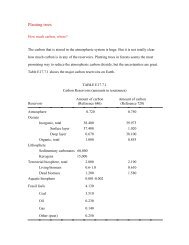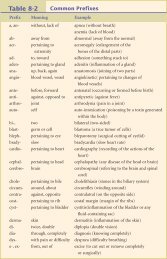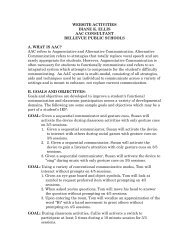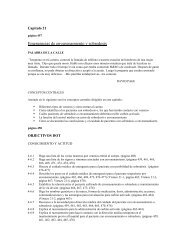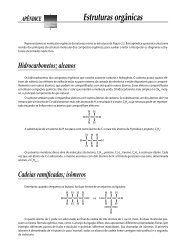chapter
chapter
chapter
You also want an ePaper? Increase the reach of your titles
YUMPU automatically turns print PDFs into web optimized ePapers that Google loves.
Figure 7.26 Radio telescopes like this one located at Green<br />
Bank, West Virginia, are used to determine accurately the<br />
distance between two distant sites. Data collected by repeated<br />
measurements have detected relative plate motions of 1 to 15<br />
centimeters per year between various sites worldwide. (Courtesy<br />
of National Radio Astronomy Observatory)<br />
mechanisms yet proposed can account for all major<br />
facets of plate tectonics. Nevertheless, researchers generally<br />
agree on the following:<br />
1. Convective flow in the rocky 2900-kilometerthick<br />
mantle—in which warm, less dense rock<br />
rises and cooler, more dense material sinks—is<br />
the basic driving force for plate movement.<br />
2. Mantle convection and plate tectonics are part of<br />
the same system. Oceanic plates represent the cold<br />
downward-moving portion of convective flow.<br />
3. The slow movements of the plates and mantle are<br />
driven by the unequal distribution of heat within<br />
Earth’s interior. This flow is the mechanism that<br />
transports heat away from Earth’s interior.<br />
What is not known with any large degree of certainty is<br />
the precise nature of this convective flow.<br />
Some researchers have argued that the mantle is<br />
like a giant layer cake, divided at a depth of 660 kilometers.<br />
Convection operates in both layers, but mixing<br />
between layers is minimal. At the other end of the spectrum<br />
is a model that loosely resembles a pot of just barely<br />
boiling water, churning ever so slowly from top to<br />
bottom over eons of geologic time. Neither model fits all<br />
of the available data. We will first look at some of the<br />
processes that are thought to contribute to plate motion<br />
and then examine a few of the models that have been<br />
proposed to describe plate-mantle convection.<br />
Slab-Pull, Ridge-Push,<br />
and Mantle Plumes<br />
Several mechanisms generate forces that contribute to<br />
plate motion. One relies on the fact that old oceanic<br />
crust, which is relatively cool and dense, sinks into the<br />
asthenosphere and “pulls” the trailing lithosphere<br />
along. This mechanism, called slab-pull, is thought to<br />
Chapter 7 Plate Tectonics 219<br />
be the primary downward arm of the convective flow<br />
operating in the mantle. By contrast, ridge-push results<br />
from the elevated position of the oceanic ridge system<br />
and causes oceanic lithosphere to gravitationally slide<br />
down the flanks of the ridge. Ridge-push, although apparently<br />
active in some spreading centers, is probably<br />
less important than slab-pull.<br />
Most models suggest that hot, buoyant plumes of<br />
rock are the upward flowing arms in the convective mechanism<br />
at work in the mantle. These rising mantle plumes<br />
manifest themselves on Earth’s surface as hot spots with<br />
their associated volcanic activity. Mapping of Earth’s interior<br />
using seismic tomography indicates that at least<br />
some of these hot plumes extend upward from the vicinity<br />
of the mantle-core boundary. Others, however, appear<br />
to originate higher in the mantle. Further, some upward<br />
flow in the mantle is not related to plumes and occurs just<br />
below the ridge crests as a result of seafloor spreading.<br />
Models of Plate-Mantle Convection<br />
Any model describing mantle convection must be consistent<br />
with the observed physical and chemical properties<br />
of the mantle. In particular, these models must<br />
explain why basalts that erupt along the oceanic ridge<br />
are fairly homogeneous in composition and depleted in<br />
certain trace elements. It is assumed that these ridge<br />
basalts are derived from rocks located in the upper mantle<br />
that experienced an earlier period of chemical differentiation,<br />
in which trace elements were removed. By<br />
contrast, higher concentrations of these elements are evident<br />
in basaltic eruptions associated with hot-spot volcanism.<br />
Because basalts that erupted in different settings<br />
have different concentrations of trace elements, they are<br />
assumed to be derived from chemically distinct regions<br />
of the mantle. Basalts associated with mantle plumes<br />
are thought to come from a primitive (less differentiated)<br />
source, which more closely resembles the average<br />
chemical composition of the early mantle.<br />
Layering at 660 Kilometers. Earlier we referred to<br />
the “layer cake” version of mantle convection. As<br />
shown in Figure 7.27A, one of these layered models<br />
has two zones of convection—a thin, convective layer<br />
above 660 kilometers and a thick one located below.<br />
This model successfully explains why the basalts that<br />
erupt along the oceanic ridges have a somewhat<br />
different composition than those that erupt in Hawaii<br />
as a result of hot-spot activity. The oceanic ridge basalts<br />
come from the upper convective layer, which is well<br />
mixed, whereas the mantle plume that feeds the Hawaiian<br />
volcanoes taps a deeper, more primitive source<br />
that resides in the lower convective layer.<br />
Despite evidence that supports this model, recent<br />
seismic imaging has shown that subducting slabs of<br />
cold oceanic lithosphere are able to penetrate the 660kilometer<br />
boundary. The subducting lithosphere serves<br />
to mix the upper and lower layers together. As a result,<br />
the layered mantle structure is lost.




